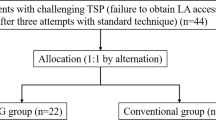Abstract
Purpose
Increasing numbers of transseptal punctures (TSP) are performed for different cardiac interventions, especially for left atrial (LA) ablation of atrial fibrillation (AF). Significant TSP-related complications may occur even by experienced operators. Any strategies to mitigate these should be adopted. Previous reports have confirmed the safety and efficacy of the first generation nitinol guidewire for TSP. The objective was to assess the safety and efficacy of a new nitinol ‘needle free’ SafeSept guidewire (NFSG) for TSP. The distal J-shaped tip (0.014 in.) of the NFSG is unchanged in design; however, the shaft is thicker (0.0315 in.) and stiffer.
Methods
This is a multicentre study evaluating TSP without a transseptal needle, using the NFSG via a standard transseptal sheath-dilator, in patients with an indication for TSP.
Results
A total of 145 consecutive unselected patients were studied. The mean patient age was 59 ± 15. Thirty-one (21.4%) were female and 43 (29.7%) had a previous procedure requiring TSP. The mean transverse LA diameter was 4.0 ± 0.8 cm. AF or LA tachycardia comprised the major indication for TSP (n = 115). Transesophageal echocardiography for direct guidance of TSP was utilised in cases performed under general anesthesia (n = 66, 45.5%). LA access by TSP using the NFSG was achieved successfully in 100% of cases after 1.6 ± 2.3 passes. There were no TSP or other major procedural complications.
Conclusions
Use of the NFSG appears to be a safe and effective method in performing TSP. The major improvement in the design of the NFSG is that TSP can be performed without a transseptal needle and exchange for a standard guidewire is not required upon establishing LA access.


Similar content being viewed by others
References
De Ponti R, Cappato R, Curnis A, Della Bella P, Padeletti L, Raviele A, et al. Trans-septal catheterization in the electrophysiology laboratory: data from a multicenter survey spanning 12 years. J Am Coll Cardiol. 2006;47(5):1037–42.
Cappato R, Calkins H, Chen SA, Davies W, Iesaka Y, Kalman J, et al. Worldwide survey on the methods, efficacy, and safety of catheter ablation for human atrial fibrillation. Circulation. 2005;111:1100–5. https://doi.org/10.1161/01.CIR.0000157153.30978.67.
Holmes DR, Kar S, Price MJ, Whisenant B, Sievert H, Doshi SK, et al. Prospective randomized evaluation of the watchman left atrial appendage closure device in patients with atrial fibrillation versus long-term warfarin therapy: the PREVAIL trial. J Am Coll Cardiol. 2014;64(1):1–12.
Rogers DP, Lambiase PD, Dhinoja M, Lowe MD, Chow AW. Right atrial angiography facilitates transseptal puncture for complex ablation in patients with unusual anatomy. J Interv Card Electrophysiol. 2006;17:29–34.
Hahn K, Gal R, Sarnoski J, Kubota J, Schmidt DH, Bajwa TK. Transesophageal echocardiographically guided atrial transseptal catheterization in patients with normal-sized atria: incidence of complications. Clin Cardiol. 1995;18(4):217–20. https://doi.org/10.1002/clc.4960180408.
Daoud EG, Kalbfleisch SJ, Hummel JD. Intracardiac echocardiography to guide transseptal left heart catheterization for radiofrequency catheter ablation. J Cardiovasc Electrophysiol. 1999;10(3):358–63. https://doi.org/10.1111/j.1540-8167.1999.tb00683.x.
Deshpande SS, Bremner S, Sra JS, Dhala AA, Blanck Z, Bajwa TK, et al. Ablation of left free-wall accessory pathways using radiofrequency energy at the atrial insertion site: transseptal versus transaortic approach. J Cardiovasc Electrophysiol. 1994;5(3):219–31. https://doi.org/10.1111/j.1540-8167.1994.tb01159.x.
Wadehra V, Buxton AE, Antoniadis AP, McCready JW, Redpath CJ, Segal OR, et al. The use of a novel nitinol guidewire to facilitate transseptal puncture and left atrial catheterization for catheter ablation procedures. Europace. 2011;13(10):1401–5. https://doi.org/10.1093/europace/eur155.
De Ponti R, Marazzi R, Picciolo G, Salerno-Uriarte JA. Use of a novel sharp-tip, J-shaped guidewire to facilitate transseptal catheterization. Europace. 2010;12(5):668–73. https://doi.org/10.1093/europace/euq060.
Katritsis GD, Siontis GC, Giazitzoglou E, Fragakis N, Katritsis DG. Complications of transseptal catheterization for different cardiac procedures. Int J Cardiol. 2013;15;168(6):5352–4.
McWilliams MJ, Tchou P. The use of a standard radiofrequency energy delivery system to facilitate transseptal puncture. J Cardiovasc Electrophysiol. 2009;20(2):238–40. https://doi.org/10.1111/j.1540-8167.2008.01323.x.
Shah DP, Knight BP. Transseptal catheterization using a powered radiofrequency transseptal needle. J Interv Card Electrophysiol. 2010;27:15–6. https://doi.org/10.1007/s10840-009-9414-7.
Greenstein E, Passman R, Lin AC, Knight BP. Incidence of tissue coring during transseptal catheterization when using electrocautery and a standard transseptal needle. Circ Arrhythm Electrophysiol. 2012;5(2):341–4. https://doi.org/10.1161/CIRCEP.111.968040.
Wieczorek M, Hoeltgen R, Akin E, Salili AR. Use of a novel needle wire in patients undergoing transseptal puncture associated with severe septal tenting. J Interv Card Electrophysiol. 2010;27:9–13. https://doi.org/10.1007/s10840-009-9460-1.
Author information
Authors and Affiliations
Corresponding author
Additional information
Publisher’s note
Springer Nature remains neutral with regard to jurisdictional claims in published maps and institutional affiliations.
Rights and permissions
About this article
Cite this article
Chow, A.W.C., Cobb, V., Sepahpour, A. et al. Transseptal puncture performed with the new needle-free ‘SafeSept’ guidewire: a multicentre experience. J Interv Card Electrophysiol 59, 29–34 (2020). https://doi.org/10.1007/s10840-019-00608-w
Received:
Accepted:
Published:
Issue Date:
DOI: https://doi.org/10.1007/s10840-019-00608-w




